The Swifts of Mexiquillo
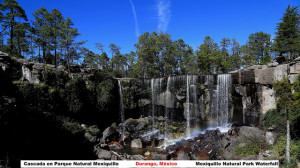
We were excited to arrive at Parque Natural Mexiquillo before the break of dawn in June. This underappreciated park is right on one of Mexico’s most celebrated birding routes, the Durango Highway — but it is an hour or two farther east than the Tufted Jay Preserve, and much less frequently visited. The drier forests of Mexiquillo host a noticeably different avifauna than the wetter areas closer to the coast. Mexiquillo is more likely to produce birds typical of the dry “sky islands” of southern Arizona: Buff-breasted Flycatcher, Western Bluebird, Plumbeous Vireo, and even American Robin. It’s much better habitat for the likes of “Type 6” Red Crossbills (which we recorded) and Eared Quetzals (which we did not find). Of course, it also has Red Warblers, Elegant Euphonias, and Rufous-capped Brush-Finches.
And it has a waterfall.
This is particularly noteworthy because the mountains of west Mexico are high and dry — and not much water means not many waterfalls. Which means not many places to look for waterfall-loving swifts.
We were very interested to see what kinds of swifts would be flying around the waterfall at daybreak. A report from 2013 had us wondering whether this would be a good place to record Black Swifts, and a tantalizing recording from Chihuahua had us wondering whether something super-rare might be lurking under the cascada (and under the radar), like the “avian unicorn” White-fronted Swift (Cypseloides storeri).
When we first arrived, before first light, all was quiet, except for the roaring water and the aerial singing of Violet-green Swallows. Off in the distance, a Spotted Owl hooted. No swifts. Soon a dawn-singing Pine Flycatcher became a serious distraction. By the time the sun was fully up, we were totally engaged in all the other wonderful birds in the park, and we had completely given up on the swifts. Until suddenly, something dark swooped by overhead with a sound like the crackling of electrical wires. Chestnut-collared Swift!
Then another group of swifts flew by, and I heard a sound familiar from the mountains of Colorado: Black Swift.
For the next hour, these two species swirled over our heads, sometimes swinging pretty low. The encounter was simultaneously a letdown and a thrill. On the one hand, it woke us up from the pipe dream of documenting some ultra-rare Cypseloides vocalizations. On the other hand, it was a terrific opportunity to spend time with two species that it can be awfully hard to see and hear well. It cleared up a long-standing mystery about whether the Black Swifts of Mexico might sound different from the ones farther north (answer: they don’t). And it gave us the field experience necessary to help identify the Chihuahua mystery swift as the first Chestnut-collared documented in that state. One key takeaway: Black and Chestnut-collared Swifts can look astonishingly similar, even when you get good, prolonged looks. But by sound, they can be separated right away.
While I concentrated more on the audio recording, Andrew was able to get some decent flight shots of the Black Swifts:
We were hoping to figure out whether the Black Swifts of Mexiquillo belonged to the northern subspecies niger, which breeds in the United States and Canada, or the southern subspecies costaricensis, which breeds in — you guessed it — Costa Rica. The birds in Mexico have been attributed to each of these subspecies by different authors. The Mexiquillo Black Swifts were surprisingly well marked, some with bright white foreheads, some with extensive white scalloping below. So we thought this might be a mark for costaricensis. But when Andrew reviewed and photographed Black Swift specimens in the Harvard collection earlier this week, he found it nearly impossible to separate the subspecies by coloration. The size difference is noticeable on the specimen table, but is subtle enough that it would be virtually useless in the field.
So, the subspecies of the Durango birds remains a bit of a mystery. Any comments or discussion would be appreciated!

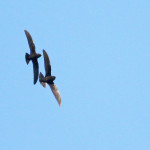


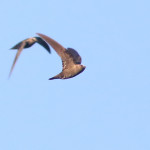
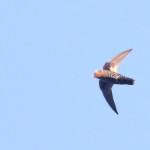


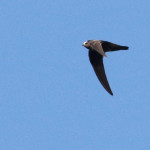
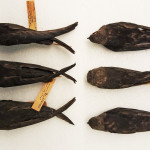
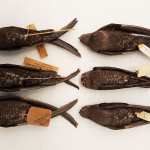

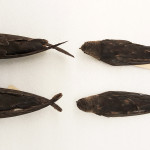
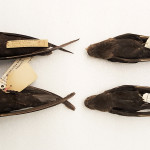
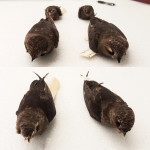
6 thoughts on “The Swifts of Mexiquillo”
Have you looked at the original descriptions of the two subspecies to see what the authors were using as the characters by which to distinguish them? I’d recommend doing that, which should help you from reinventing the wheel and searching for separating characters in the dark. I just looked at Hellmayr, but other than describing a new taxon from the Lesser Antilles, he didn’t really comment on characters among populations of C. niger.
Hi Dan,
I should have mentioned that we did look at Ridgway 1911 (the subspecies costaricensis was described by Ridgway 1910). He says of costaricensis: “Similar to borealis, but decidedly darker, the adult female with feathers of abdomen and flanks more broadly tipped with white, and averaging slightly smaller; adult male similar to that of jamaicensis, but wing averaging longer and tail decidedly shorter, and general color of head and neck decidedly more grayish.”
Note that Ridgway, who had access to some Mexico specimens, considered the range of the northern subspecies borealis to reach as far south as Oaxaca. But Webster (1958), working with Phillips, took some new specimens in Zacatecas and declared them costaricensis, saying, “Mexican birds are closer to borealis in the restriction of the ventral white markings and the lesser extent of white frosting on the head, but closer to costaricensis in wing and tail lengths. The color of back and belly is as black as costaricensis and blacker than borealis in each case.”
Stiles and Negret (1994) reversed Webster’s identification and put the Zacatecas specimens back in borealis. So it’s all a little confusing.
To build on what Nathan said, I was specifically looking for the features mentioned in Ridgway 1911 when looking at the specimens, and I could not see any of the differences he mentioned, other than size. The photos I took that are shown above do seem to show the costaricensis specimens as a bit paler than the borealis ones, but I think that was an artifact of the camera, as the whole left side of the photo is darker. When looking at the specimens in person I did not note a color difference.
Interesting. Webster’s comments would suggest to me that “costaricensis” may just be the southern terminus of a cline of characters stretching from the Pacific Northwest south to Central America, and perhaps shouldn’t be recognized as a taxon at all. Phillips, it should be noted, was a “super-splitter” of subspecies. Lorie Binford once told me “Phillips would have happily accepted the concept of quatronomials had other taxonomists been willing to go along with them”… so that the implication that Phillips supported the existence of costaricensis should perhaps not be taken as reason to consider the taxon particularly valid… I’d say that most taxonomists today (at least, those who believe in subspecies at all) would require that subspecies not be points on clines in plumage or size variation.
* Laurie Binford (oops, my bad!)
FYI I saw a number of presumed Black Swifts in the central valley of Oaxaca in July 2015. I don’t get to see Black Swifts very often in Canada/USA, but these birds immediately struck me as being paler than the northern Black Swifts – indeed, paler than just about any Cypseloides/Streptoprocne I had seen.
I have placed a number of average-quality photos on this web page; if anyone wants larger-image versions, just contact me. I wish I could comment on the vocalizations, but the first site was a gas station in town, and very noisy; the birds were calling, as I recall:
http://www.martinreid.com/Misc%20website/MX2015BlackSwift.html
Comments are closed.